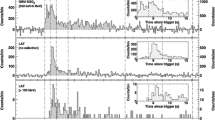Abstract
Gamma-ray production by particles escaping from a pulsar into the surrounding nebula is considered. The gamma-ray emission decreases with time and such pulsar-nebula complexes will be observed as transient sources.
Similar content being viewed by others
References
Bahcall, J. N., Rees, M. J. and Salpeter, E. E.Ap. J., 1970,162, 737.
Gold, T...Nature, 1969,221, 25.
Trimble, V. and Woltjer, L.Ap. J., 1971,163, 197.
Shlovsky, I. S...Supernovae, Wiley, Interscience Publication, New York, 1968.
Ogelman, H. B., Delvaille, J. P. and Greisen, K.Phys. Rev. Lett., 1956,56, 16, 491.
Duthie, J. G., Cobb, R. and Stewart, J.Phys. Rev. Lett., 1966,17, 263.
Frye, G. M., Staib, J. A., Zych, A. D., Hopper, V. D., Rawlinson, W. R. and Thomas, J. A.Nature, 1969,223, 1320.
Fazio, G. G., Helmken, H. F., Rieke, G. H. and Weeks, T. C.Acta Physica Hungaricae, 1970,29 (Suppl. 1), 115.
Author information
Authors and Affiliations
Additional information
Communicated by Prof. R. R. Daniel,f.a.sc.
Rights and permissions
About this article
Cite this article
Apparao, K.M.V., Rengarajan, T.N. Transient gamma-ray sources. Proc. Indian Acad. Sci. 73, 257–260 (1971). https://doi.org/10.1007/BF03047117
Received:
Issue Date:
DOI: https://doi.org/10.1007/BF03047117




